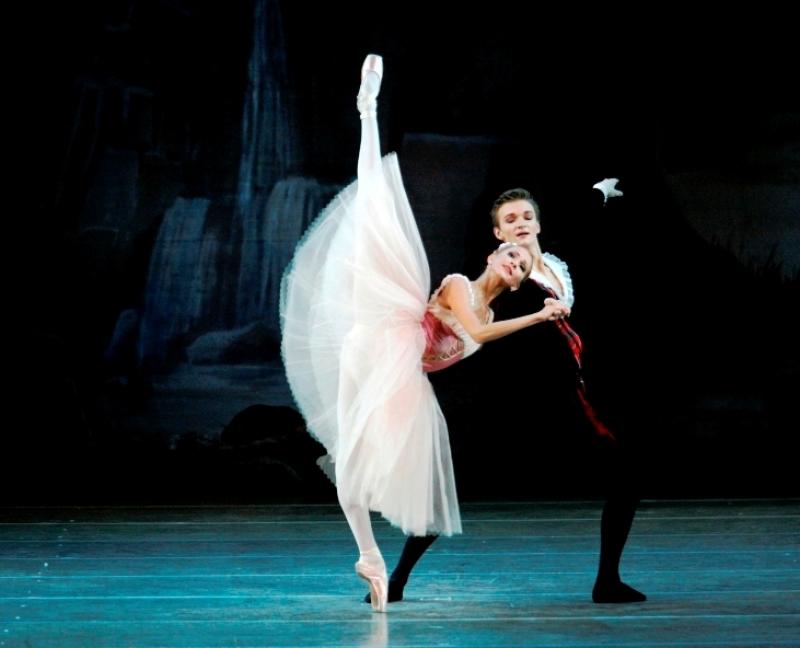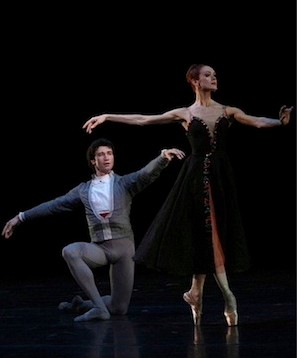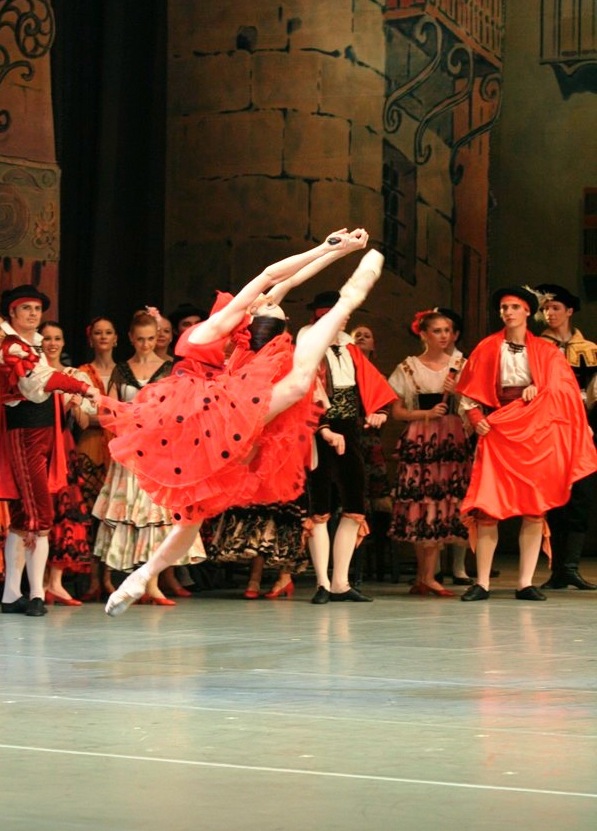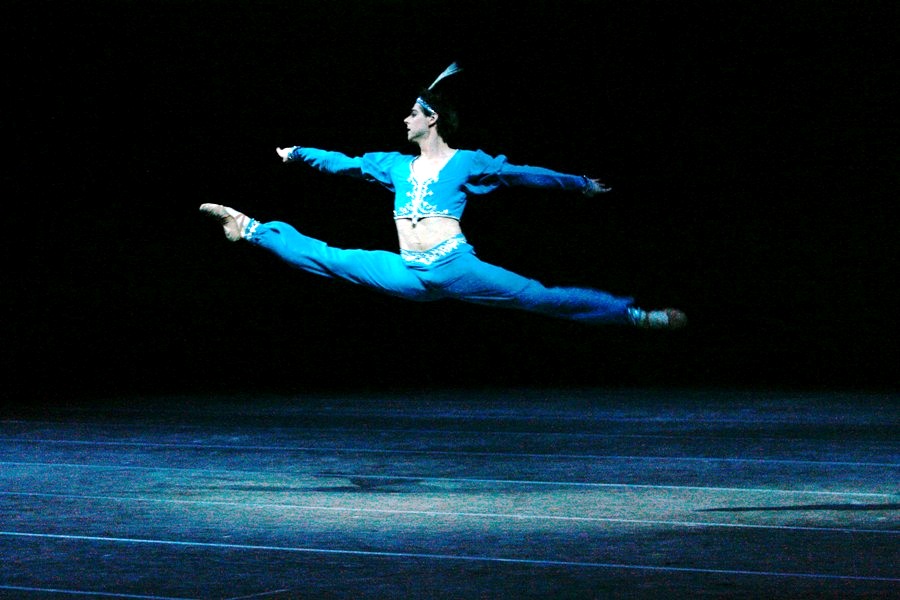Mariinsky Ballet, Royal Opera House: The Highlights | reviews, news & interviews
Mariinsky Ballet, Royal Opera House: The Highlights
Mariinsky Ballet, Royal Opera House: The Highlights
The thrills, hokey moments, new faces and glories of a superb season

The Mariinsky Ballet has just completed a three-week season, with terrific highs (and the odd low). This was the 50th anniversary of the Mariinsky's (then Kirov's) first London visit, in 1961, and it is worth highlighting the role impresarios Victor and Lilian Hochhauser have played in the cultural life of London.
So, to work.
GREATEST THRILL: Balanchine’s Scotch Symphony, beyond doubt for me. This will probably elicit the most raised eyebrows. In a gorgeous evening devoted to New York City Ballet choreographers George Balanchine and Jerome Robbins, the pre-Revolution-Mariinsky-trained Balanchine won plaudits for his Ballet Imperial, with the very Imperial Viktoria Tereshkina thundering through the Tchaikovsky ballet. But for me, she was too imperial, and imperious, by half. Unlike Ismene Brown, I found her dancing hard, bordering on harsh. Instead, I was beguiled, entranced and in fact melted by the delicate Romanticism of Scotch Symphony. Here Balanchine, with typical witty economy, paid homage to Bournonville’s La sylphide, just without the story. The up-and-coming Alexander Sergeyev (main picture, above), not perfect by any means, was however touchingly alert to the ballet’s tender charm. And I succumbed.
 MOST WELCOME RETURN: Again, from the same programme, it was a pleasure to see Robbins’s In the Night, three couples’ psychodramas played out to Chopin Nocturnes. In the wrong hands, this piece can look like Antony Tudor at his most Edwardian. (There are lots of "Never-darken-my-doors" melodrama gestures.) But in the right hands, and those hands included all 12 on stage at the Opera House, Robbins’s outsider view of interior drama is transfiguring. Which leads me to:
MOST WELCOME RETURN: Again, from the same programme, it was a pleasure to see Robbins’s In the Night, three couples’ psychodramas played out to Chopin Nocturnes. In the wrong hands, this piece can look like Antony Tudor at his most Edwardian. (There are lots of "Never-darken-my-doors" melodrama gestures.) But in the right hands, and those hands included all 12 on stage at the Opera House, Robbins’s outsider view of interior drama is transfiguring. Which leads me to:
HOKIEST MOMENT SUCCESSFULLY NEGOTIATED: The third couple in In the Night quarrel and misunderstand one another, finally to be reconciled as the woman slowly kneels at her partner’s feet, finally bowing her head to the ground, palms upturned in supplication. Only the very greatest can carry this off. Happily, Uliana Lopatkina is indeed among the very greatest, and this tall, uncanny dancer, a being from another world (pictured above left), touchingly and truly came down to earth: by humbling herself, she showed her greatness of spirit.
 EXCITING NEWCOMER: Don Quixote is not the Mariinsky’s natural emotional territory, better negotiated by the more rumbustious Bolshoi. (I make an exception for the thrilling Diana Vishneva [pictured right].) However, Espada, the bullfighter, with a cameo pas de deux in the first act, stole the show when danced by soloist Alexander Sergeyev. It was not his technique, although he has that in spades, but his sense of presentation: he drew himself up, torero-style, in a grand backbending arc, carving out space, and a place for himself on a stage otherwise overstuffed with fuss and bother. One to watch out for.
EXCITING NEWCOMER: Don Quixote is not the Mariinsky’s natural emotional territory, better negotiated by the more rumbustious Bolshoi. (I make an exception for the thrilling Diana Vishneva [pictured right].) However, Espada, the bullfighter, with a cameo pas de deux in the first act, stole the show when danced by soloist Alexander Sergeyev. It was not his technique, although he has that in spades, but his sense of presentation: he drew himself up, torero-style, in a grand backbending arc, carving out space, and a place for himself on a stage otherwise overstuffed with fuss and bother. One to watch out for.
BAGS OF TECHNIQUE: The Firebird is not much my thing: too much panto, too little dancing is my usual view. If anyone could change my mind, it would be Ekaterina Kondaurova, "Big Red" as she quickly became nicknamed. With her blazing red hair matching her blazing tutu, she was a febrile, dazzlingly strong Firebird, all tremor, nerves and extraordinary steely jumps.
MOST EXCITING MIXED MARRIAGE: It’s going to take more than one viewing to get to grips with Alexei Ratmansky’s Anna Karenina. But on a first visit, one definitive scene is the horse race where Anna inadvertently reveals to her husband her feelings for Vronsky, which is a magical combination of MacMillan’s expressionistic narrative style and Bournonville’s delicately steely bouncing choreography: it sounds perverse, but the inventive Ratmansky pulls it off.
OLD FAITHFUL: Mariinsky followers know that the orchestra of the Mariinsky Theatre is one of its glories, and in particular on nights when Boris Gruzin is conducting, a joy. So it proved, night after night.
 SADDEST EVENING: The dreary Soviet production of Swan Lake (in which not only does Odette not die, but Von Rothbart is beaten to death with his own wing: kids, don’t try this at home!). The dancers seemed aware that this production has gone well beyond camp. They performed valiantly, but one wonders why they have to.
SADDEST EVENING: The dreary Soviet production of Swan Lake (in which not only does Odette not die, but Von Rothbart is beaten to death with his own wing: kids, don’t try this at home!). The dancers seemed aware that this production has gone well beyond camp. They performed valiantly, but one wonders why they have to.
GREAT REGRET: Laid low by a bug, I missed La bayadère. (The wonderful Vladimir Shklyarov, pictured left, as Solor; photo: N Razina.) The corps, so magnificent in La sylphide, Swan Lake and Scotch Symphony, were clearly born and trained to perform the Kingdom of the Shades scene.
Note to Hochhausers: can we have them back again soon please?
- The Mariinsky Theatre Opera and Ballet 2011-12 season opens with Verdi's opera Aida on 26 September and Lavrovsky's ballet Romeo and Juliet on 29 September
The future of Arts Journalism
You can stop theartsdesk.com closing!
We urgently need financing to survive. Our fundraising drive has thus far raised £49,000 but we need to reach £100,000 or we will be forced to close. Please contribute here: https://gofund.me/c3f6033d
And if you can forward this information to anyone who might assist, we’d be grateful.

Subscribe to theartsdesk.com
Thank you for continuing to read our work on theartsdesk.com. For unlimited access to every article in its entirety, including our archive of more than 15,000 pieces, we're asking for £5 per month or £40 per year. We feel it's a very good deal, and hope you do too.
To take a subscription now simply click here.
And if you're looking for that extra gift for a friend or family member, why not treat them to a theartsdesk.com gift subscription?
more Dance
 'We are bowled over!' Thank you for your messages of love and support
Much-appreciated words of commendation from readers and the cultural community
'We are bowled over!' Thank you for your messages of love and support
Much-appreciated words of commendation from readers and the cultural community
 Giselle, National Ballet of Japan review - return of a classic, refreshed and impeccably danced
First visit by Miyako Yoshida's company leaves you wanting more
Giselle, National Ballet of Japan review - return of a classic, refreshed and impeccably danced
First visit by Miyako Yoshida's company leaves you wanting more
 Quadrophenia, Sadler's Wells review - missed opportunity to give new stage life to a Who classic
The brilliant cast need a tighter score and a stronger narrative
Quadrophenia, Sadler's Wells review - missed opportunity to give new stage life to a Who classic
The brilliant cast need a tighter score and a stronger narrative
 The Midnight Bell, Sadler's Wells review - a first reprise for one of Matthew Bourne's most compelling shows to date
The after-hours lives of the sad and lonely are drawn with compassion, originality and skill
The Midnight Bell, Sadler's Wells review - a first reprise for one of Matthew Bourne's most compelling shows to date
The after-hours lives of the sad and lonely are drawn with compassion, originality and skill
 Ballet to Broadway: Wheeldon Works, Royal Ballet review - the impressive range and reach of Christopher Wheeldon's craft
The title says it: as dancemaker, as creative magnet, the man clearly works his socks off
Ballet to Broadway: Wheeldon Works, Royal Ballet review - the impressive range and reach of Christopher Wheeldon's craft
The title says it: as dancemaker, as creative magnet, the man clearly works his socks off
 The Forsythe Programme, English National Ballet review - brains, beauty and bravura
Once again the veteran choreographer and maverick William Forsythe raises ENB's game
The Forsythe Programme, English National Ballet review - brains, beauty and bravura
Once again the veteran choreographer and maverick William Forsythe raises ENB's game
 Sad Book, Hackney Empire review - What we feel, what we show, and the many ways we deal with sadness
A book about navigating grief feeds into unusual and compelling dance theatre
Sad Book, Hackney Empire review - What we feel, what we show, and the many ways we deal with sadness
A book about navigating grief feeds into unusual and compelling dance theatre
 Balanchine: Three Signature Works, Royal Ballet review - exuberant, joyful, exhilarating
A triumphant triple bill
Balanchine: Three Signature Works, Royal Ballet review - exuberant, joyful, exhilarating
A triumphant triple bill
 Romeo and Juliet, Royal Ballet review - Shakespeare without the words, with music to die for
Kenneth MacMillan's first and best-loved masterpiece turns 60
Romeo and Juliet, Royal Ballet review - Shakespeare without the words, with music to die for
Kenneth MacMillan's first and best-loved masterpiece turns 60
 Help to give theartsdesk a future!
Support our GoFundMe appeal
Help to give theartsdesk a future!
Support our GoFundMe appeal
 Vollmond, Tanztheater Wuppertal Pina Bausch + Terrain Boris Charmatz, Sadler's Wells review - clunkily-named company shows its lighter side
A new generation of dancers brings zest, humour and playfulness to late Bausch
Vollmond, Tanztheater Wuppertal Pina Bausch + Terrain Boris Charmatz, Sadler's Wells review - clunkily-named company shows its lighter side
A new generation of dancers brings zest, humour and playfulness to late Bausch

Add comment